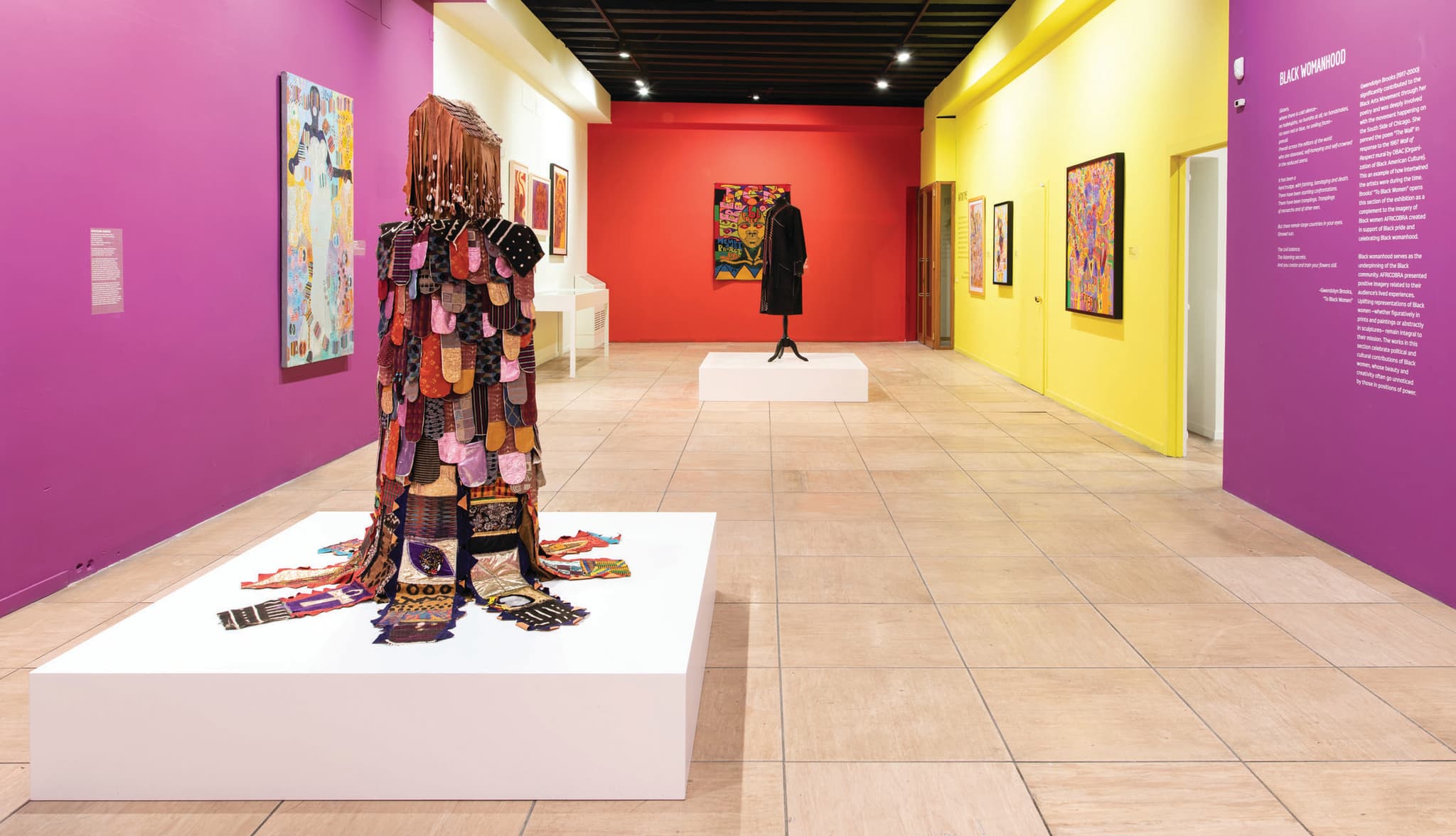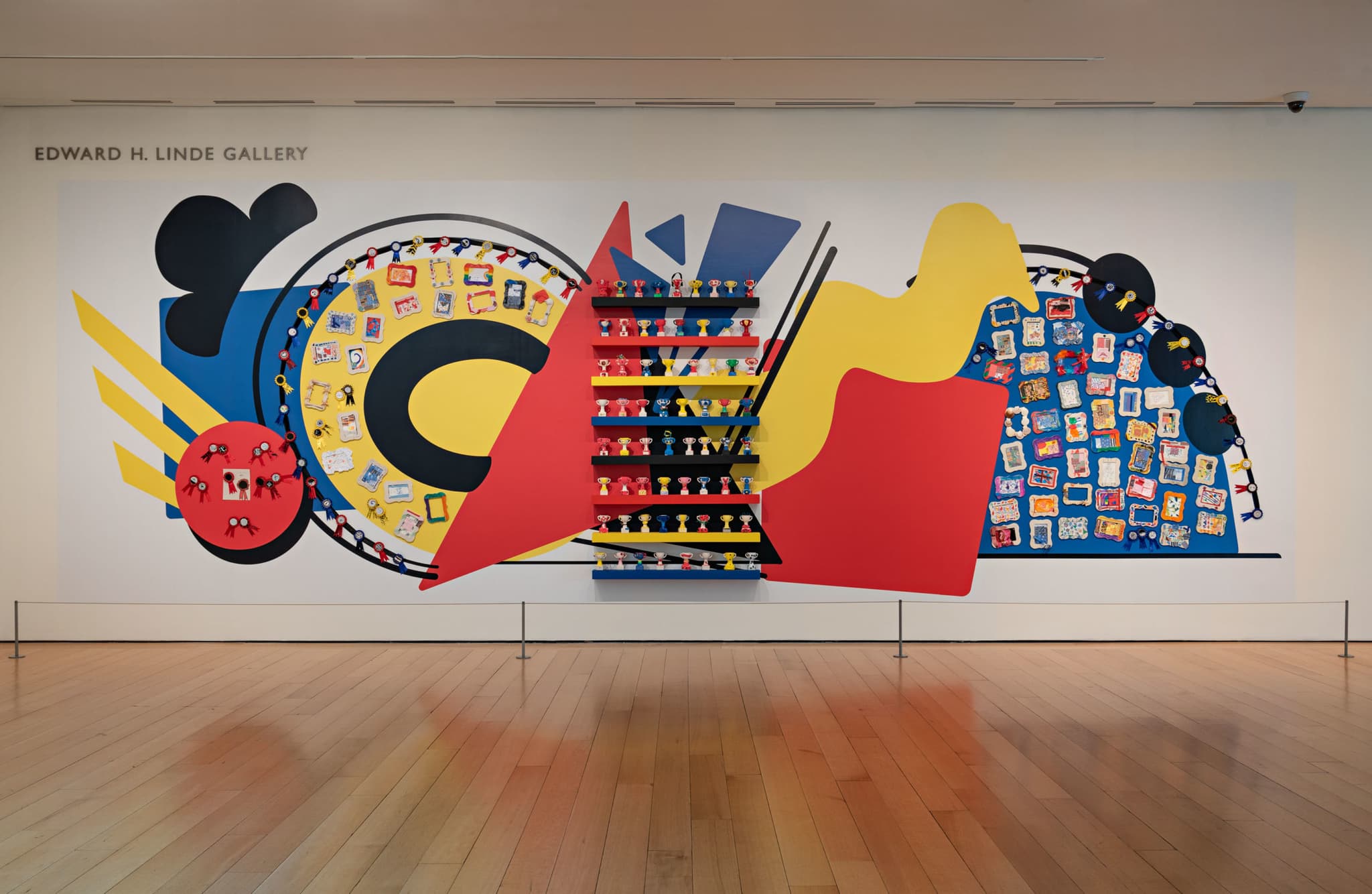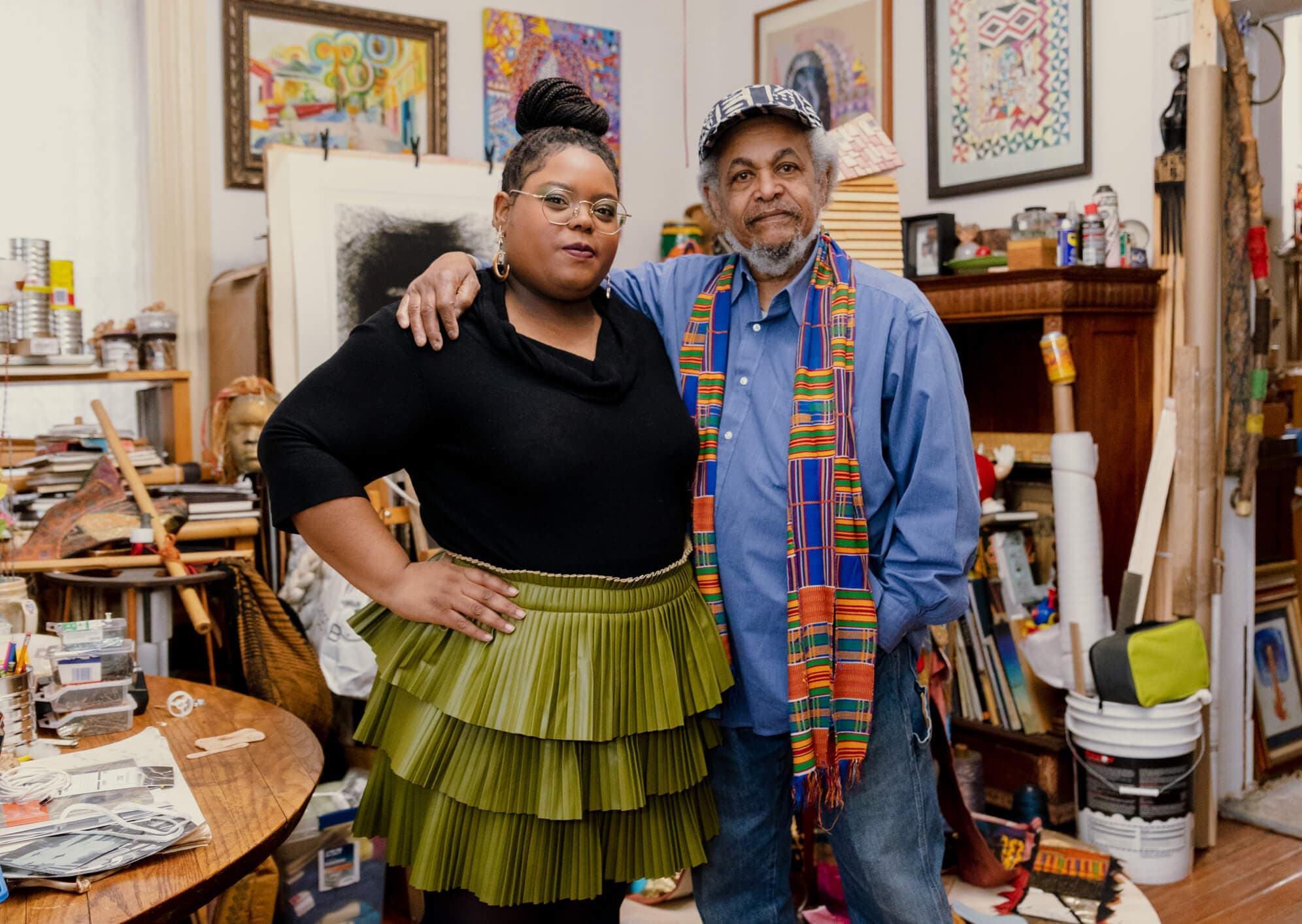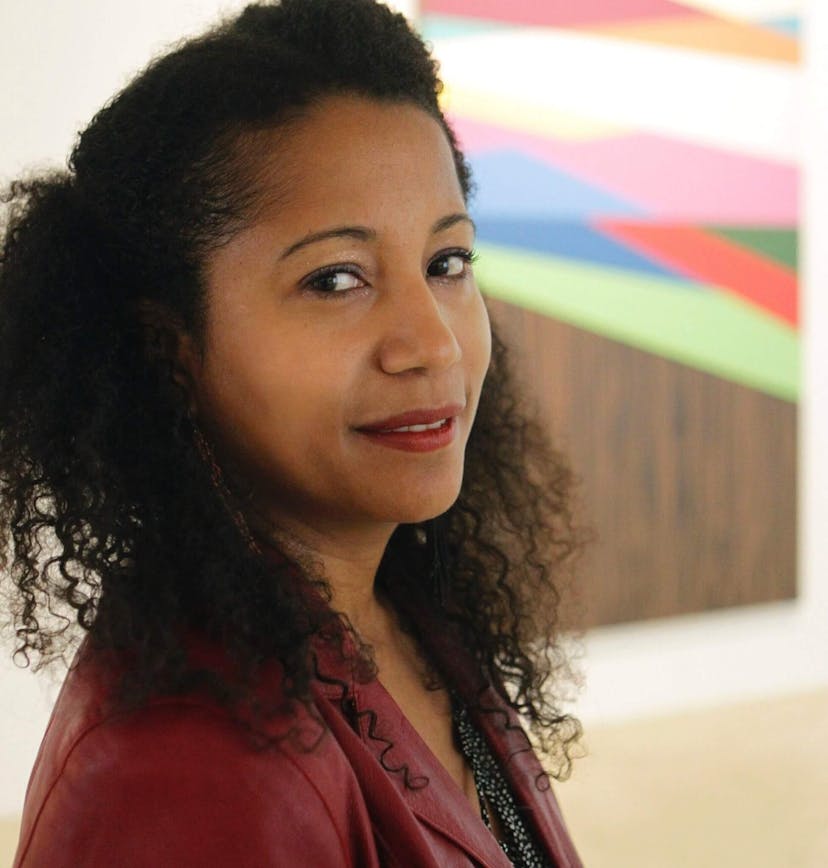When I first heard Chanel Thervil say that Napoleon Jones-Henderson was her mentor, I was in awe. Napoleon’s pioneering career as a founding member of AfriCOBRA (African Commune of Bad Relevant Artists) is one of courage and depth.
Founded in Chicago during the watershed year of 1968, artist collective AfriCOBRA, formed as an antidote to the proliferation of images that denigrated Black communities in an effort to create images that would reflect and celebrate the diverse traditions, beliefs, cultures, and, in the words of many members, “sensibilities” of African Americans. As a result, AfriCOBRA is part of a larger story that reaches back to the Harlem Renaissance, the Civil Rights Movement and the Black Arts Movement, and reverberates into the current Black Lives Matter era where efforts to reimagine museums and art in public spaces are just as crucial as marching and voting.
As an artist and educator, Thervil leads by example. She radiates a compassion and wisdom that fuels her sculptural portraits of notable Black community members such as Liz Walker, Ekua Holmes, as well as Napoleon himself. Though several generations younger, Thervil’s work embodies many of the same “sensibilities” of Jones-Henderson’s AfriCOBRA peers, yet rather than looking to create portraits of a nation, Thervil looks local first to find and display Black joy.
What’s evident in Thervil & Jones-Henderson’s conversation is their willingness to be unabashed fans of each other’s vision. In a crowded multi-screen media landscape, they use their practices to create beauty that has a material impact on their communities and model a generosity of spirit that directly translates into collaborative works and public art projects that create the possibility for connection.
Introduction by Dell Marie Hamilton

Front sculpture: Napoleon Jones-Henderson, Word Warrior-ess June Jordan, 2005–10, featured as part of “AFRICOBRA: Nation Time” at Biennale Arte, 2019. Presented by bardoLA, MOCA North Miami, and Kavi Gupta Gallery. Photo by Ugo Carmeni Studio courtesy of bardoLA
Chanel Thervil: I’m jazzed to be chatting with you! I’ll start off by saying that you’ve been a really influential mentor to me, and I see a lot of the great things that you do with your own work and all the wonderful things that you’ve done with AfriCOBRA as a blueprint for so many of my creations. So with that in mind, I wanted to ask you, who were influential mentors to you?
Napoleon Jones-Henderson: Oh, well, there were many to be perfectly honest. One would be Margaret TaylorBurroughs of Chicago, for sure. Elizabeth Catlett, Jacob Lawrence, John Wilson, and Lois Mailou Jones. Each of them has provided guidance or been an aspiration, and I wanted to have the same kind of commitment and fortitude that I saw in them with regard to how they carried themselves in life as image makers.
All five of these people were personal friends over years. They were my mentors. They were older than me. They were the people I looked up to and learned a lot from. And ultimately, as I got older and matured a bit, I found myself being considered by them as a colleague, as you are with me, a colleague.
CT: Hey, it’s a party!
NJH: It’s interesting how the aspects of colleague and mentor can so easily overlap. But again, those were principal individuals beyond the multitude of others, and all the AfriCOBRA members have also been mentors as well as colleagues.
CT: One of the conversations we had when we first met was about how there’s this really nasty rhetoric around artists seeing each other as competitors and just this discord around looking at a fellow creative and seeing them as something that’s more like an iron that sharpens the iron rather than a competition thing.
In that early conversation, you said, “The thing that comes up for me when I see you do great things is pride.” And now, when I see my students do great things, I’m proud because I know that their interaction with me has spawned something new for them, and that’s a positive, that’s something to get excited about rather than something to fear.
NJH: Oh, absolutely
CT: I think that’s so in alignment with what you say about having mentors and mentees be colleagues as well, because I feel like I’m now in a space where I’m a colleague with you and I’m like, “Whoa, how did that happen?”
NJH: Because you put some grease on your wheel and you rolled on along, you know?

Chanel Thervil, Community Arts Initiative: Patterns of Greatness, Museum of Fine Arts, Boston, May 8 to October 17, 2021, Edward H. Linde Gallery. Photo © Museum of Fine Arts, Boston.
CT: Yeah, indeed. Do you have any particular works that best showcase your mentors’ influence on you?
NJH: I don’t have any particular works, because their influence is present in all my work. Say, Margaret Burroughs, her work was always centered in the community, undergirded by her sense of politics and humanity and surely responding to life, from her upbringing in Louisiana to her adult life in Chicago. With Elizabeth Catlett, she was always articulating the importance of using one’s artistic practice as a tool for uplifting humanity, and then particularly addressing inhumanity toward people of African descent, not just in the United States or the Western Hemisphere, but internationally. I think that’s always present in my work and in the work of AfriCOBRA as a whole.
With John Wilson, it’s his ability to exhibit, if you will, the kind of flexibility to move between mediums, from painting and drawing to lithographs— which he was known for at the start of his career—to his monumental sculptural work, which in no way is any less powerful and impactful than his graphics or paintings. And he was just wonderful as a human being. And again, he was someone who spent some time in Chicago along with Margaret when he was much younger as a student at the Art Institute of Chicago, which is my alma mater. I went to that joint as well. And with Jake [Jacob Lawrence], I really, really, really would say that Jake’s sense of storytelling is extraordinary.
His studio practice is just awesome. He would create a series with twenty-five or thirty works, so it became not only about the paintings, but the narrative that went along with them. So even if the viewer wasn’t drawn to the visual, they might be drawn to the story. All of my mentors worked in different materials and mediums, and that inspired me to understand that there are no restrictions.
CT: Those are amazing people to have as mentors and friends.
NJH: Oh yeah. And now I’ve had the privilege of seeing your work develop since we first met in 2014. I’ve been most excited to see you approach your art-making with a sense of boldness and confidence. When we first met, you had a strong background in art education and you were working in that field, but it meant that your personal practice was coming second. What’s changed for you?
CT: Well, I’m living the self-employed life now. The most drastic change has been how time is used. Previously, I was working nine to five, then squeezing in my art late at night. Now that I no longer have a nine-to-five, I have more space to do collaborations.
NJH: Studio practice, from my perspective, is always 24/7. Sometimes I wake up from a dream and have to get right to work. What are some of those recent collaborations you mentioned having more time for?
CT: In 2021, I worked on Patterns of Greatness with the Museum of Fine Arts. I made that installation with over a hundred little ones from ages nine to twelve from Boys and Girls Clubs across Boston. I held art workshops over Zoom, using art as a way for them to talk about the elements of their lives that they feel excited about.
Whether it was drawings informed by music that they liked or honoring their favorite person through sculpture, or collaging their favorite kind of weather, all of these mini projects ended up being pieces of Patterns of Greatness at the MFA.
NJH: Would you say your approach to public art commissions or collaborative projects is different from your 38 other work?
CT: I think one of the main ways it’s different is just the intensity of collaboration, because I think there’s collaboration in all of the works that I make, but it’s a different type of dance with one person versus public art. I have to approach my public artwork with a greater focus on who the potential audience might be and the different ways that I might want to reach them through my work. What types of openings can I leave for people to dive into and get excited?
NJH: So I guess you could say that the public art commissions are a conversation with your community every step of the way, whereas the portraits are more a singular conversation between yourself and the subject. Are you inclined more toward one over the other?
CT: I think it depends on my mood really, because I know everyone has a different kind of rhythm. I notice that there are certain times of the year where I’d prefer to be doing different things. When the weather’s warm, I want to be out and mingling with folks. And when the weather’s cold, I want to be indoors with the heat on in my studio.
NJH: I can dig that, because I likewise tend to gravitate toward works that speak as both singular works and public commissions, and they’re affected by the environment, such as now, when we’re getting longer amounts of daylight. When that happens, my energy is always higher, and my work is always more energetic.
CT: The rhythm is key.
NJH: Here’s a question for you: Do you consider yourself an artist or an image maker and do you see a difference between the two?
CT: The nuance for me is that “image maker” holds more weight, because I think about what Paul Goodnight, who was your student at MassArt and is now a nationally recognized artist, once said. He said, “Those who control the image control the mind.” Art can serve several purposes, but image making is a little more substantive because it has that added weight of duty
NJH: Right. The responsibility is there. And that is precisely why at AfriCOBRA, we use the term image makers and not artists.
CT: But I think you can be both. I think that I’m both.
NJH: Oh, absolutely. They’re not exclusive from each other in any kind of way. But from my perspective, each of them has a particular sense of commitment and responsibility that is different from the other. An image maker comes with a history and set of responsibilities that are beyond you.
CT: Definitely. What’s something about your art practice that you’re most proud of?
NJH: That I wake up and I get up, and I get busy every day. Also, the blessing and opportunity that my practice has allowed me to be in sharing, collaborative relationships with my peers, colleagues, and most importantly with younger artists. I’ve been able to do that in a formal context by teaching at colleges and universities through workshops with public school systems and so forth. But especially, in the last ten to maybe fifteen years, I’ve been able to work with individuals like you and Flolynda [Jean] and other younger artists. It’s an invaluable opportunity to manifest what my practice is, which is aesthetic uplift and spiritual nourishment. And so to share that with individuals is equally as important as the work that I make.

(left) Chanel Thervil, Soothing Pieces: Portrait of Billy, from the Quarantine Self-Care Series, 2020. Tablecloth, acrylic, plastic, assorted papers, masking tape. 42″x 42″. Photo courtesy of the artist. (right) Napoleon Jones-Henderson, TCB, 1970. Wool. 72″x 54″. Installation view, “Napoleon Jones-Henderson: I Am As I Am—A Man,” The Institute of Contemporary Art/Boston, 2022. Photo by Mel Taing. © Napoleon Jones-Henderson
CT: Yeah, I feel that. I think that collaboration is honoring those who came before, being open to conversation consistently, and offering curiosity about another person in a way that allows them to step up and share themselves with you. That’s also a big part of my own personal practice. One project that illustrates this is the Quarantine Self-Care Series, where I interviewed people about how they were caring for themselves and then used their responses as inspiration for the images and portraits I was creating.
NJH: Oh, absolutely! And I see that as a reiteration of the tapestry TCB, Taking Care of Business. That’s a mantra that came from the community about a sense of self-care. Self-care doesn’t speak to individuals as much as it does to the collective community. That’s 1970, and here we are in 2022, singing in the same tune and doing the same dance to the same kind of music.
CT: Yeah. Shout out to the parallels! I feel like your current solo exhibition at the ICA is filled with histories and parallels. How did you select which pieces would be a part of that show?
NJH: The selection of pieces was an easy journey because I was working with curator Jeffrey De Blois. We met at the Boston Art Book fair in 2017. From there, we had a series of conversations about my work as well as AfriCOBRA. When Jeff invited me to have a solo show at the museum, he wanted to figure out how to fit fifty years of work into the galleries that documented how my work shifted from Chicago to Boston. So we began thinking about my work between 1970 and 1974, which is when I was living in Chicago and working closely with other AfriCOBRA members.
When I moved to Boston, I found this metallic yarn that was manufactured in the ’20s at an old mill, and that yard allowed me to manifest one of the AfriCOBRA aesthetic tenants of shine. I’ve been making work out of that yarn ever since, and I still have plenty left.
I guess the other big shift we wanted to capture after moving to Boston was that I started making works that were more narrative-driven. I made work about the experiences of people in the African diaspora by honoring people like Aretha Franklin, June Jordan, James Baldwin, Billie Holiday, and so many others. Another piece on view in the exhibition which I think is really representative of what I do is a piece I started in 2002, which was around the fortieth anniversary of the death of those three little girls that died in the church bombing in Birmingham, Alabama. Since then, I’ve made more work that honors the lives of Black and African people who have died unceremoniously. It’s all about honoring these ancestors. Even if I’m not directly related to them, we’re all connected. These are shrines to those ancestors around. I’m most honored that I can have fifty years of my work on view overlooking the Atlantic Ocean. The Eastern Seaboard is where Africans first arrived in this country. It’s a continuum.
What about you, what are you working on now?
CT: I just got the Ashé Ashé grant from the Boston Ujima Project. I’m going to be working on portraits that explore nature versus nurture. I’ll be interviewing people and asking them their thoughts on whether they think nature or nurture influenced them most. I’m not quite sure where the project will land. They might even debut on Instagram.
NJH: Do you think that nature or nature are in competition with each other?
CT: I don’t think they have to be. I think the schools of thought act as though they’re in competition with each other, but my personal thought is that it’s a little bit of both.
NJH: Okay. So it’s not nature versus nurture. It’s nature and nurture. So are they tributaries to a mainstream that come together? I think this means we have more to talk about. When the weather gets a little warmer and you get back this way, we’re going to sit down and break some bread, and I’ll roast another chicken and make a big salad. And we’ll pick this conversation back up.
“Napoleon Jones-Henderson: I Am As I Am—A Man” is on view at the Institute of Contemporary Art/Boston through July 24, 2022.
Napoleon Jones-Henderson attended the Sorbonne, Paris, holds a B.F.A. from the School of the Art Institute of Chicago, and a M.F.A. from Maryland Institute College of Art in Baltimore. He is a longstanding member of the influential artist collective African Commune of Bad Relevant Artists (AfriCOBRA). He has received awards both for his artwork and in recognition of his community in-reach and curatorial efforts championing Black Art internationally. He is executive director of the Research Institute of African and African Diaspora Arts in Roxbury, Massachusetts, where he lives and works.
Chanel Thervil is a Haitian American artist and educator who uses varying combinations of abstraction and portraiture to convene communal dialogue around culture, social issues, and existential questions. At the core of her practice lies a desire to empower and inspire tenderness and healing among communities of color through the arts. She holds a bachelor of fine arts in painting from Pace University and a master’s degree in art education from Massachusetts College of Art and Design. She has created educational collaborations and commissions with institutions including the Museum of Fine Arts, Boston, Boston Children’s Museum, and PBS Kids.
This interview was originally published in Issue 08: Face to Face.




